Crossref Citations
This article has been cited by the following publications. This list is generated based on data provided by
Crossref.
Till, Rupert
2019.
Sound Archaeology: A Study of the Acoustics of Three World Heritage Sites, Spanish Prehistoric Painted Caves, Stonehenge, and Paphos Theatre.
Acoustics,
Vol. 1,
Issue. 3,
p.
661.
Yioutsos, Nektarios-Petros
2019.
Between Worlds.
p.
113.
Valenzuela, Jose
Díaz-Andreu, Margarita
and
Escera, Carles
2020.
Psychology Meets Archaeology: Psychoarchaeoacoustics for Understanding Ancient Minds and Their Relationship to the Sacred.
Frontiers in Psychology,
Vol. 11,
Issue. ,
Wolfe, Kristina
Swanson, Douglas
and
Till, Rupert
2020.
The frequency spectrum and geometry of the Ħal Saflieni Hypogeum appear tuned.
Journal of Archaeological Science: Reports,
Vol. 34,
Issue. ,
p.
102623.
Wilmering, Thomas
Moffat, David
Milo, Alessia
and
Sandler, Mark B.
2020.
A History of Audio Effects.
Applied Sciences,
Vol. 10,
Issue. 3,
p.
791.
Barbara, Jonathan
Grech, Jeremy
Camilleri, Joseph
McGurk, Silvio
and
Theuma, Charles
2021.
Digital Heritage. Progress in Cultural Heritage: Documentation, Preservation, and Protection.
Vol. 12642,
Issue. ,
p.
703.
Barbara, Jonathan
2022.
Re-Live History: An immersive virtual reality learning experience of prehistoric intangible cultural heritage.
Frontiers in Education,
Vol. 7,
Issue. ,
S. Umbarkar, Ajinkya
V. Nandanwar, Deoram
and
P. Chimankar, Omprakash
2022.
Preliminary Archaeoacoustic Study of Kanheri Caves in Mumbai (Maharashtra, India).
Sound&Vibration,
Vol. 56,
Issue. 2,
p.
193.
Barratt, R.P.
2022.
Simulating a stone roof for the Maltese Neolithic temples: Analysing stress to understand specialisation.
Digital Applications in Archaeology and Cultural Heritage,
Vol. 27,
Issue. ,
p.
e00236.
Navas-Reascos, Gustavo
Naal-Ruiz, Norberto E.
Alonso-Valerdi, Luz María
and
Ibarra-Zarate, David I.
2023.
Acoustic measurements of Edzna: A Mayan archaeological place in Mexico.
Journal of Archaeological Science: Reports,
Vol. 52,
Issue. ,
p.
104269.
Till, Rupert
2023.
Presenting Archaeoacoustics Results Using Multimedia and VR Technologies.
Open Archaeology,
Vol. 9,
Issue. 1,
Navas-Reascos, Gustavo
Alonso-Valerdi, Luz M.
and
Ibarra-Zarate, David I.
2023.
Archaeoacoustics around the World: A Literature Review (2016–2022).
Applied Sciences,
Vol. 13,
Issue. 4,
p.
2361.
Navas-Reascos, Gustavo
Wilhelm-deAlba, Guillermo
Alonso-Valerdi, Luz María
and
Ibarra-Zarate, David I.
2023.
Acoustic Characterization of Edzna: A Measurement Dataset.
Scientific Data,
Vol. 10,
Issue. 1,
Rainio, Riitta
and
Hytönen-Ng, Elina
2023.
Ringing Tone and Drumming Sages in the Crevice Cave of Pirunkirkko, Koli, Finland.
Open Archaeology,
Vol. 9,
Issue. 1,
